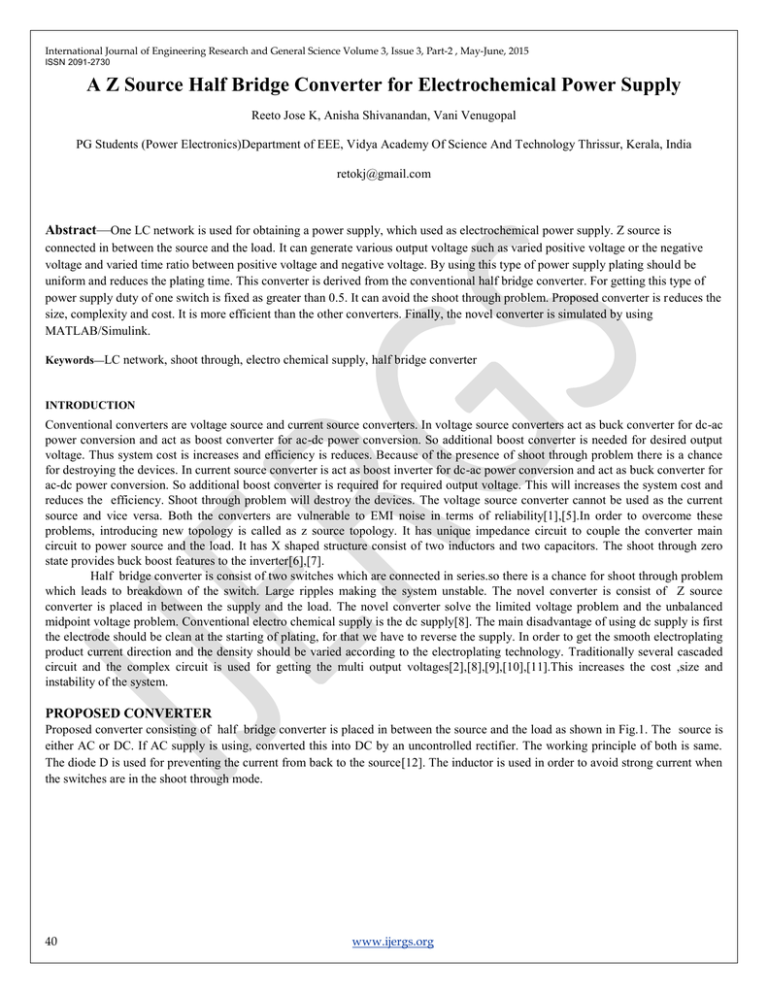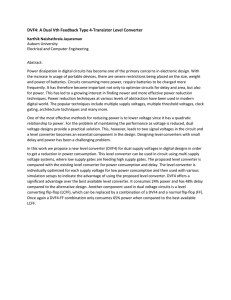A Z Source Half Bridge Converter for Electrochemical Power Supply
advertisement

International Journal of Engineering Research and General Science Volume 3, Issue 3, Part-2 , May-June, 2015
ISSN 2091-2730
A Z Source Half Bridge Converter for Electrochemical Power Supply
Reeto Jose K, Anisha Shivanandan, Vani Venugopal
PG Students (Power Electronics)Department of EEE, Vidya Academy Of Science And Technology Thrissur, Kerala, India
retokj@gmail.com
Abstract—One LC network is used for obtaining a power supply, which used as electrochemical power supply. Z source is
connected in between the source and the load. It can generate various output voltage such as varied positive voltage or the negative
voltage and varied time ratio between positive voltage and negative voltage. By using this type of power supply plating should be
uniform and reduces the plating time. This converter is derived from the conventional half bridge converter. For getting this type of
power supply duty of one switch is fixed as greater than 0.5. It can avoid the shoot through problem. Proposed converter is reduces the
size, complexity and cost. It is more efficient than the other converters. Finally, the novel converter is simulated by using
MATLAB/Simulink.
Keywords—LC network, shoot through, electro chemical supply, half bridge converter
INTRODUCTION
Conventional converters are voltage source and current source converters. In voltage source converters act as buck converter for dc-ac
power conversion and act as boost converter for ac-dc power conversion. So additional boost converter is needed for desired output
voltage. Thus system cost is increases and efficiency is reduces. Because of the presence of shoot through problem there is a chance
for destroying the devices. In current source converter is act as boost inverter for dc-ac power conversion and act as buck converter for
ac-dc power conversion. So additional boost converter is required for required output voltage. This will increases the system cost and
reduces the efficiency. Shoot through problem will destroy the devices. The voltage source converter cannot be used as the current
source and vice versa. Both the converters are vulnerable to EMI noise in terms of reliability[1],[5].In order to overcome these
problems, introducing new topology is called as z source topology. It has unique impedance circuit to couple the converter main
circuit to power source and the load. It has X shaped structure consist of two inductors and two capacitors. The shoot through zero
state provides buck boost features to the inverter[6],[7].
Half bridge converter is consist of two switches which are connected in series.so there is a chance for shoot through problem
which leads to breakdown of the switch. Large ripples making the system unstable. The novel converter is consist of Z source
converter is placed in between the supply and the load. The novel converter solve the limited voltage problem and the unbalanced
midpoint voltage problem. Conventional electro chemical supply is the dc supply[8]. The main disadvantage of using dc supply is first
the electrode should be clean at the starting of plating, for that we have to reverse the supply. In order to get the smooth electroplating
product current direction and the density should be varied according to the electroplating technology. Traditionally several cascaded
circuit and the complex circuit is used for getting the multi output voltages[2],[8],[9],[10],[11].This increases the cost ,size and
instability of the system.
PROPOSED CONVERTER
Proposed converter consisting of half bridge converter is placed in between the source and the load as shown in Fig.1. The source is
either AC or DC. If AC supply is using, converted this into DC by an uncontrolled rectifier. The working principle of both is same.
The diode D is used for preventing the current from back to the source[12]. The inductor is used in order to avoid strong current when
the switches are in the shoot through mode.
40
www.ijergs.org
International Journal of Engineering Research and General Science Volume 3, Issue 3, Part-2 , May-June, 2015
ISSN 2091-2730
Figure 1. Proposed Converter
Some assumptions are considered for the working of the proposed converter.L 1=L2,C1=C2=Cm1=Cm2,All the components are ideal.
Here duties of switches are D1 and D2 by switches S1 and S2 respectively. D1 =0.7and D2=0.5
There are 3 modes of operations[3].
Mode 1:It is a shoot through state as shown in Fig.2. The capacitor C 1 and C2 discharges the energy to the inductor. The diode D
became reverse biased. According to the loop C2-Load-Cm2 the output voltage of the converter is taken as
(1)
Figure 2. mode 1:S1 and S2 is ON
Mode 2:In loop 1,L1 discharges the energy to C2.
(2)
In loop 2 L2 discharges the energy to C1 as shown in Fig.3.
(3)
41
www.ijergs.org
International Journal of Engineering Research and General Science Volume 3, Issue 3, Part-2 , May-June, 2015
ISSN 2091-2730
Figure 3. mode 2: S1 ON and S2 OFF
Mode 3:voltage across the C2 is increases because L1 discharges the energy to the C2. voltage across the C1 is increases because L2
discharges the energy to the C1.From the loop Vin-D-C1-Load-Ccm2,the output voltage is
(4)
Figure 4. mode 3:S1 OFF and S2 ON
42
www.ijergs.org
International Journal of Engineering Research and General Science Volume 3, Issue 3, Part-2 , May-June, 2015
ISSN 2091-2730
Figure 5. Waveforms of z source half bridge converter
PARAMETER DESIGN
In this section designing the inductance and the capacitance.
In the design section input is taken as the dc (Vdc) supply.
A. Design of the capacitor
Determine the voltage second characteristics of L1,
Vc1=Vc2=(2 – D1 – D2)Vd/(3 − (D=1 + D2))
Vcd2= (2Vc2− Vd)D1 – Vc2 + Vd.
(6)
(7)
Positive output voltage of the converter is obtained from the equation (3).
Vp={(1 – D1)Vd }/{3− 2(D1 + D2)}
(8)
Negative output voltage of the converter is
Vn=− {D1Vd}/{3-2(D1+D2)}
43
(9)
www.ijergs.org
International Journal of Engineering Research and General Science Volume 3, Issue 3, Part-2 , May-June, 2015
ISSN 2091-2730
From (6),(8) and (9)
When S1 is on Vc2={2-D1-D2}V0/{1-D1}
(10)
When S2 is on and S1 is off Vc2={2-D1-D2}V0/{-D1}
(11)
The current through the Ic2 and IL2 is I0/2
Differential equation of the capacitor is
C2=Ic2dt/dvc2
(12)
dt={D1+D2-1}T
(13)
dvC2 = xc%Vc2M
(14)
Xc% is the permitted fluctuation range.Vc2M is the maximum rated voltage of C2.
Substituting equation (13) and (14) into (12)
C2 ={Io(D1 + D2 − 1)T}/{2Xc%Vc2M}
B. Design of the inductor
C. Differential equation of the inductance is
VL2=VL2dtL/diL2
(15)
diL2=XL%IL2
(16)
VL2M=Vc2M
(17)
Substituting (13),(16) and (17) into (15) leads to
L2={2Vc2M(D1 + D2 − 1)T}/{XL%I0}
SIMULATION RESULT
Simulation parameters for the proposed converter and its values are given in the table 1.
Table 1. Simulation parameters and values
Parameters
Values
Vin
0.24
D1,D2
0.7T,0.5T
44
www.ijergs.org
International Journal of Engineering Research and General Science Volume 3, Issue 3, Part-2 , May-June, 2015
ISSN 2091-2730
L1,L2
100µH
C1,C2,Cm1,Cm2
470µF
Figure 6. Simulation diagram of proposed converter
Figure 7. output waveform
CONCLUSION
The z source half bridge converter can be used for electrochemical supply when the duty of the switch S 1 is greater than 0.5T.Either dc
or ac supply can be used as the input supply. By using this supply, get smooth electroplating product and plating time can be reduced.
Novel converter is remove the all the drawbacks of conventional electrochemical supply. Efficiency and stability of the system is
greater as compared to conventional one. The proposed converter is reduces the cost as the traditional one. Novel converter can solve
the limited voltage problem.
REFERENCES:
F. Z. Peng, ―Z-source inverter,‖ IEEE Trans. Ind. Appl., vol. 39, no. 2,pp. 504–510, Mar./Apr. 2003. 1998.
[2] R. Caves. W.M Zhang,M.H Deng,Y.Q Pei and Z.A Wang,H. ―Design and optimization of high current power supply for
electrochemistry‖.in Proc.IPEC,2010,pp.86-91
[3] Guidong Zhang, Zhong Li, Bo Zhang,Dongyuan Qiu, Wenxun Xiao, and Wolfgang A. Halang "A Z-Source Half-Bridge
Converter" IEEE Trans on industrial electronics,Vol. 61, no.3,March 2014.
[4] Muhammad H Rashid,Power Electronics,Devices, and Apllications, Third Edition.Pearson Publications.
[1]
45
www.ijergs.org
International Journal of Engineering Research and General Science Volume 3, Issue 3, Part-2 , May-June, 2015
ISSN 2091-2730
[5] B. Zhao, Q. G. Yu, Z. W. Leng, and X. Y. Chen, ―Switched Z-source isolated bidirectional DC–DC converter and its phaseshifting shoot through bivariate coordinated control strategy,‖ IEEE Trans. Ind. Electron., vol. 59, no. 12, pp. 4657–4670, Dec.
2012.
[6] Y. C. Hung, F. S. Shyu, C. J. Lin, and Y. S. Lai, ―New voltage balance technique for capacitors of symmetrical half-bridge
converter with current mode control,‖ in Proc. PEDS, 2003, pp. 365–369.
[7] D. Boroyevich, D. Zhang, and P. Ning, ―A shoot-through protection scheme for converters built with SiC JFETs,‖ IEEE Trans.
Ind. Appl., vol. 46, no. 6, pp. 2495–2500, Nov./Dec. 2010.
[8] W. M. Zhang, M. H. Deng, Y. Q. Pei, and Z. A. Wang, ―Design and optimization of high current power supply for
electrochemistry,‖ in Proc. IPEC, 2010, pp. 86–91.
[9] P. J. Stout and D. Zhang, ―High-power magnetron Cu seed deposition on 3-D dual inlaid features,‖ IEEE Trans. Plasma Sci., vol.
30, no. 1, pp. 116- 117, Feb. 2002.
[10] X. Hu, Z. Y. Ling, X. H. He, and S. S. Chen, ―Controlling transmission spectra of photonic crystals under electrochemical
oxidization of aluminum,‖ J. Electrochem. Soc., vol. 156, no. 5, pp. C176–C179,2009.
[11] X. Hu, Z. Y. Ling, T. L. Sun, and X. H. He, ―Tuning optical properties of photonic crystal of anodic alumina and the influence of
electrodeposition,‖J. Electrochem. Soc., vol. 156, no. 11, pp. D521–D524, 2009.
[12] B. M. Ge, Q. Lei, W. Qian, and F. Z. Peang, ―A family of Z-source matrix converters,‖ IEEE Trans. Ind. Electron., vol. 59, no. 1,
pp. 35–46,Jan. 2012
46
www.ijergs.org



